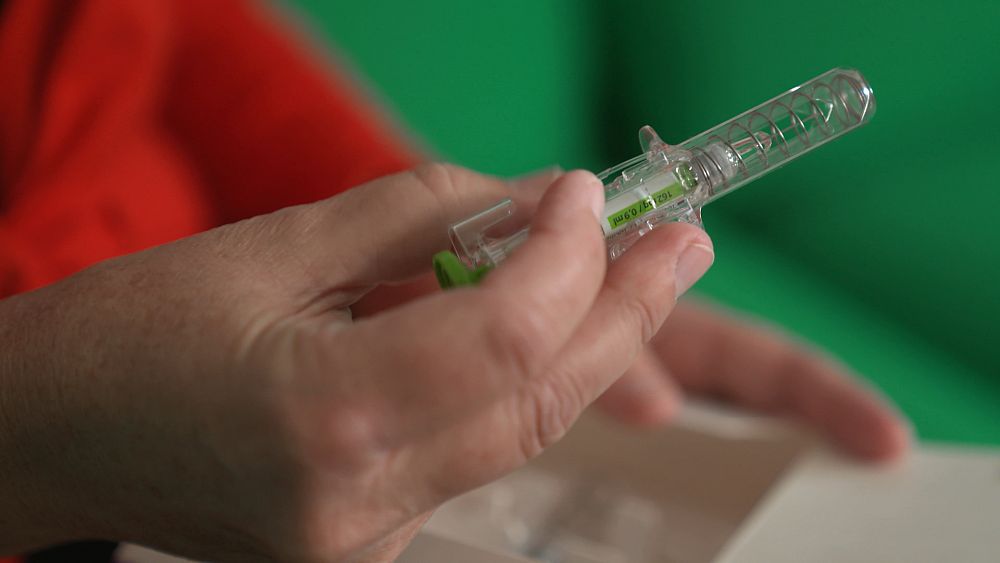The European Commission’s pharmaceutical reform would improve access to cheaper biosimilar medicines and speed up market access.
Connie Ziegler was diagnosed with rheumatoid arthritis when she was a young girl.
“When I was about a year and a half old, my parents told me that my knees were starting to hurt especially. And that I didn’t want to walk very far. And I started to hurt. Soon after , and with the first symptoms, I was diagnosed with juvenile rheumatoid arthritis”
She began treatment for her condition in her early 20s. Then, about ten years ago, doctors advised them to replace their usual medications with biosimilars.
Biosimilars are biological medicines that are copies of approved reference medicines, although cheaper to manufacture and more affordable for patients and healthcare systems.
We went to find out what it was all about.
What are biosimilars?
The European Medicines Agency defines biosimilars as “a biological medicine very similar to another biological medicine already approved in the EU (called a “reference medicine”) in terms of structure, biological activity and efficacy, safety and immunogenicity profile (the intrinsic capacity of proteins and other biological drugs to provoke an immune response)“.
They are similar to branded medicines (reference medicine) because they both contain biological material in their composition (such as bacteria, yeast or proteins for example), although biosimilars have some variations in their active substance compared to to the brand medicine. . This is due to the biological nature of the drug. Biosimilars are different from “generic” versions of biologic drugs because they are exact chemical copies of a brand name drug.
However, biosimilars still undergo strict EU testing and approval before entering the market. They are evaluated by the EMA scientific committees which examine the majority of applications for marketing authorization for biosimilar medicines. Medicines are evaluated according to the same standards of pharmaceutical quality, safety and effectiveness that apply to all biological medicines authorized in the EU.
When are they used?
Biologics and biosimilars provide treatment options for patients with chronic and often debilitating diseases such as diabetes, autoimmune diseases and cancers.
“At different times in my life, it took me a while to find the right medicine for me. So I was worried when I was told I was going to switch to a biosimilar, would it work as well?”explains Connie Ziegler. “I had to talk to my doctor about it.But I also thought they wouldn’t give it to me if it wasn’t acceptable. So of course I was willing to try it. There was another package, and it looked a little different. But for me, I had no change in how I was treated or how I felt.“
Like Connie, thousands of Danish patients have successfully switched to biosimilars in recent years. Denmark was a pioneer in their use. The country also has a good tradition of monitoring its patients.
Biosimilars in the EU
The EMA authorized the first biosimilar in 2006. Since then, 105 have been approved in the European Union.
Other candidates are subject to strict scrutiny, said Steffen Thirstrup, EMA’s chief medical officer.
“What we’re looking for here is to reassure (the public) that the manufacturer can produce these products consistently and safely. That they deliver what they promised to produce and that they have demonstrated that the product, from a molecular point of view, is similar to the reference product. Some critics and those who have doubts about biosimilars would say that the standards are less strict. But that’s absolutely not true. We would impose the same standards regardless of the type of drug we are dealing with. When generics were introduced 30 or 40 years ago, we had the same concerns. There are still rumors that generics, because they are cheaper, offer lower quality. And it’s not true“.
Impact of biosimilars
So, as soon as biosimilars became available, experts began studying their impact. Senior consultant in rheumatology, Bente Glintborg has participated in several of these studies.
“When biosimilars came to market, it was obvious for us to look at this data prospectively: let’s say, OK, these patients moved from one drug to another. So how are the outcomes for patients, how effective are the drugs, is it the same?” she explains.
She and her team studied the outcomes of more than 1,000 patients who switched to a biosimilar drug, compared to a comparison group treated with the reference drug the previous year.
“The results were almost identical. We could barely untangle the lines. This showed us that patients’ systems were accepting this switch to biosimilar drugs and that they were getting the same results they would have had with the original drug.” She adds.
Recognizing these advances, the European Commission’s pharmaceutical reform aims to improve the availability of biosimilars and generic medicines to ensure that more patients can access even more affordable medicines.
According to the European Commission, modulated incentives should allow biosimilars to enter the market up to 2 years earlier than today.
In the Netherlands, the European Medicines Agency will continue to play a key role at advisory and regulatory levels.
#Biosimilars #cheaper #effective #alternative #branded #drugs
Image Source : www.euronews.com

